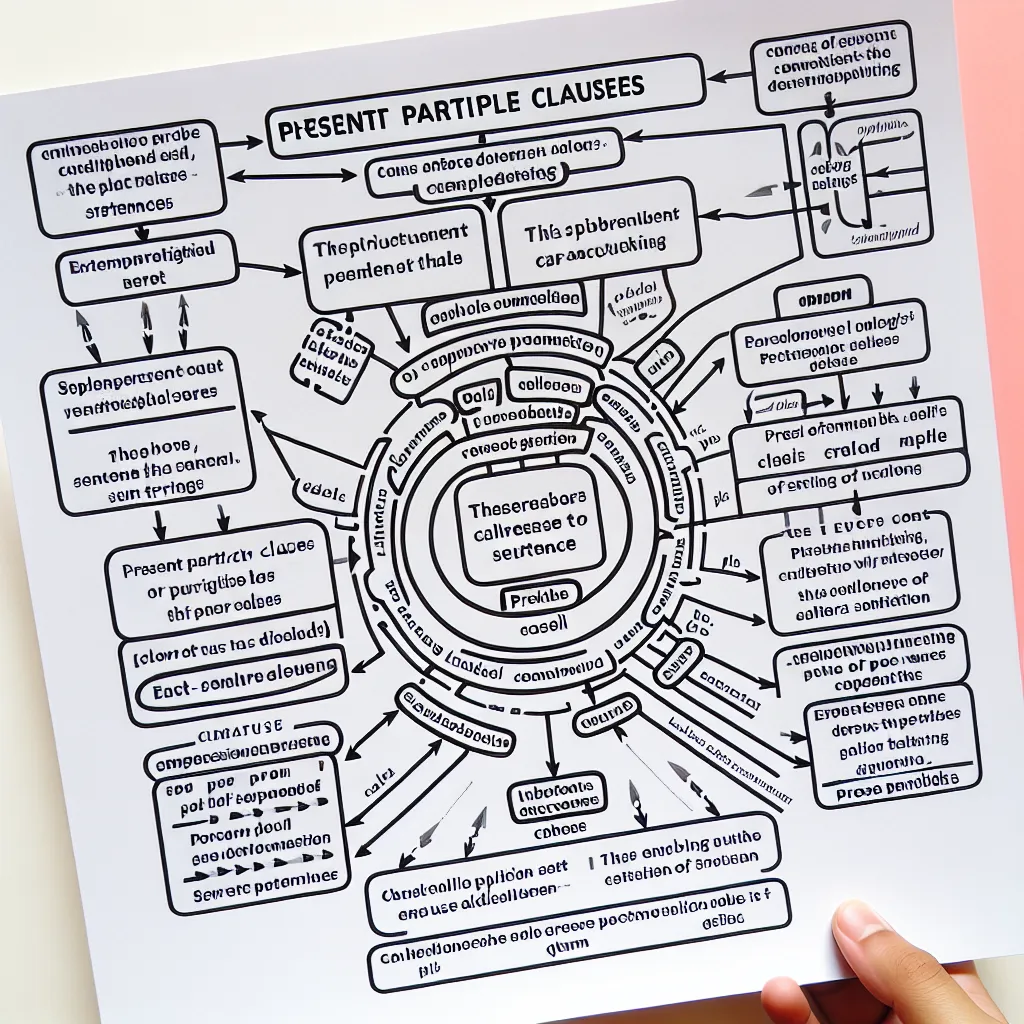Present participle clauses are a powerful grammatical tool that can significantly enhance your IELTS writing score by adding additional information concisely and elegantly. These clauses are frequently used in IELTS Writing Task 2 essays and Task 1 reports to provide supplementary details, reasons, or explanations. Let’s explore how to master this structure and use it effectively in your IELTS exam.
Understanding Present Participle Clauses for Additional Information
Present participle clauses, also known as -ing clauses, are a type of non-finite clause that can be used to add extra information to a main clause. They are formed using the -ing form of a verb and can replace a full subordinate clause, making your writing more concise and sophisticated.
For example:
- “The student, struggling with the difficult question, asked for help.”
- “Realizing the importance of practice, many IELTS candidates dedicate hours to improving their skills.”
In these sentences, the bolded parts are present participle clauses that provide additional information about the subject of the main clause.

Formula and Grammar Rules
The basic formula for using present participle clauses for additional information is:
[Subject], [Present Participle Clause], [Main Clause]
or
[Main Clause] [Present Participle Clause]
Key grammar rules to remember:
- The subject of the participle clause must be the same as the subject of the main clause.
- The present participle clause can come before or after the main clause.
- When the clause comes after the main clause, it’s often separated by a comma.
- These clauses can express a variety of relationships: time, reason, result, or add extra information.
Applying Present Participle Clauses in IELTS Writing
IELTS Writing Task 2 Example
Consider this example from an IELTS Writing Task 2 essay on environmental issues:
“Many people, realizing the devastating effects of climate change, are now adopting more sustainable lifestyles. Governments, responding to this growing concern, have begun implementing stricter environmental regulations. Focusing on renewable energy sources, some countries have made significant progress in reducing their carbon footprint.”
Analysis:
- The first two sentences use present participle clauses to provide reasons for the actions described in the main clauses.
- The third sentence starts with a present participle clause to show the method by which progress is being made.
IELTS Writing Task 1 Example
In a Task 1 report describing a process:
“The recycling process begins with collection. Trucks, collecting recyclable materials from households, transport them to sorting facilities. At these facilities, workers, using both manual and automated methods, separate the materials into different categories. Having been sorted, the materials are then processed and prepared for reuse.”
Analysis:
- The participle clauses here add details about how each step of the process is carried out.
- This structure allows for a more flowing and cohesive description of the process.
Strategies for High Band Scores
To achieve a higher band score in IELTS Writing, consider these strategies:
- Variety in sentence structure: Mix present participle clauses with other complex structures to demonstrate range.
Example (Band 7-8):
“While some argue against stricter environmental regulations, citing potential economic drawbacks, many experts believe these measures are essential for long-term sustainability.”
- Precise vocabulary: Use specific and sophisticated vocabulary in your participle clauses.
Example (Band 8-9):
“Harnessing cutting-edge renewable technologies, forward-thinking nations are spearheading the global transition to clean energy.”
- Appropriate use in different contexts: Adapt your use of participle clauses to suit different essay types and topics.
Example (Band 7-8) for an advantage/disadvantage essay:
“Online education, offering flexibility and accessibility, has become increasingly popular. However, lacking face-to-face interaction, it may not be suitable for all learning styles.”
Common Mistakes to Avoid
- Dangling participles: Ensure the subject of the participle clause matches the subject of the main clause.
Incorrect: “Walking down the street, the beautiful architecture caught my eye.”
Correct: “Walking down the street, I was captivated by the beautiful architecture.”
-
Overuse: While present participle clauses are effective, using them too frequently can make your writing sound repetitive.
-
Incorrect tense: Remember to use the present participle for actions happening simultaneously with the main clause.
Incorrect: “Studied for hours, the student felt prepared for the exam.”
Correct: “Having studied for hours, the student felt prepared for the exam.”
- Misplaced commas: Be careful with comma placement, especially when the participle clause comes after the main clause.
Incorrect: “The city implemented new recycling programs resulting in a significant reduction in landfill waste.”
Correct: “The city implemented new recycling programs, resulting in a significant reduction in landfill waste.”
Conclusion
Mastering present participle clauses for additional information can significantly enhance your IELTS Writing performance. By providing concise, additional details, these structures allow you to create more sophisticated and cohesive essays and reports. Remember to practice using them in various contexts and to balance them with other complex structures for the best results.
For further practice, try incorporating present participle clauses into essays on topics such as technological advancements, environmental challenges, or social issues. This will help you become more comfortable using this structure across a range of IELTS Writing topics.